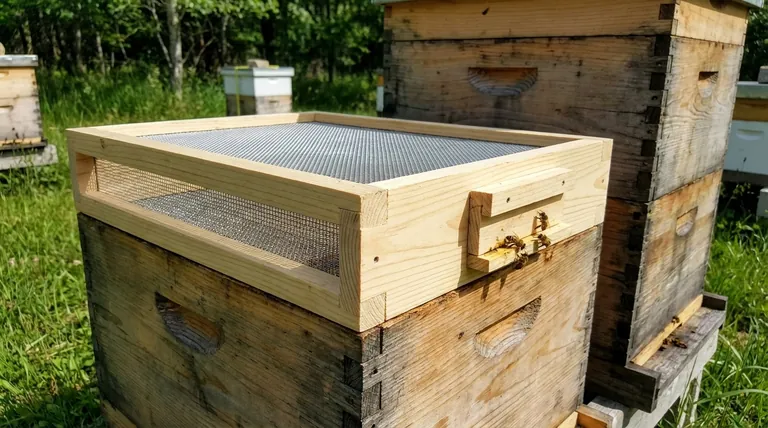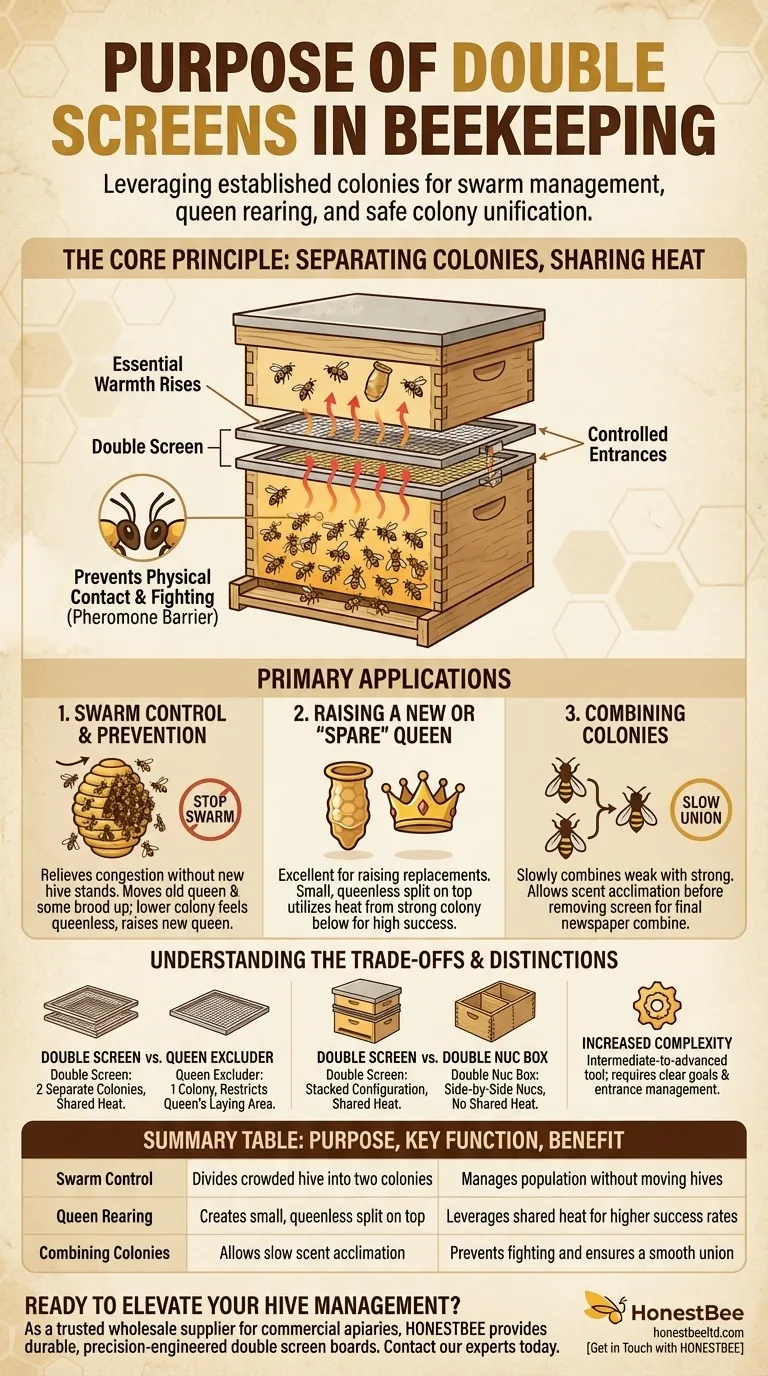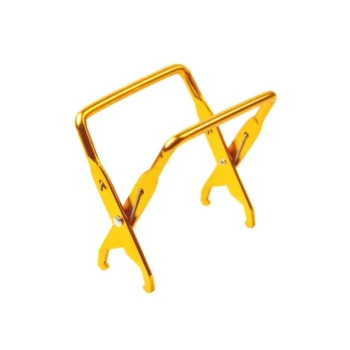At its core, a double screen board is a specialized tool used to divide a single beehive stack into two separate, self-contained colonies. Beekeepers primarily use it to manage the swarm instinct, raise a new queen in one of the separated colonies, or unite two colonies slowly and safely.
The true purpose of a double screen is to leverage the resources of a strong, established colony to support a new or manipulated one within the same hive stack. It achieves this by separating the queens and workers while allowing the critical sharing of heat between the two populations.

The Core Principle: Separating Colonies, Sharing Heat
How a Double Screen Works
A double screen board is a thin hive body rim containing two layers of wire screen, separated by a small air gap. This construction is critical.
The two layers of screen prevent bees from the upper and lower colonies from making physical contact, including touching antennae. This ensures the pheromones of the two queens do not cause fighting through the screen.
The board also features multiple small, closable entrances on its rim. These entrances allow the beekeeper to control which colony exits from which direction, a key component of its strategic use.
The True Separation
Unlike a queen excluder, which only blocks the queen while allowing worker bees to pass through, a double screen prevents all bees from moving between the two sections.
This creates two functionally distinct colonies within a single vertical stack, each with its own queen (or one being intentionally queenless) and its own entrance to the outside world.
The Primary Benefit: Shared Warmth
The most significant advantage of this system is that heat from the populous lower colony rises, providing essential warmth to the typically smaller or newer colony on top.
This shared warmth dramatically increases the success rate of raising a new queen or nurturing a small nucleus (nuc) colony, especially during cooler weather.
Primary Applications for the Double Screen
Method 1: Swarm Control and Prevention
When a strong colony becomes too crowded, its natural instinct is to swarm. A double screen provides an effective way to relieve this congestion without creating a new, separate hive stand.
By placing the double screen between hive boxes, the beekeeper can move the old queen and some brood to the top box. The lower colony, now feeling queenless, focuses its energy on raising a new queen instead of swarming.
Method 2: Raising a New or "Spare" Queen
A double screen is an excellent tool for raising new queens, ensuring you have replacements ready if a colony's queen fails. This is a common strategy to prepare for winter losses.
You can create a small, queenless split in a box on top of the screen. The heat from the strong colony below helps this small population successfully raise a new queen from a provided queen cell or a frame of fresh eggs. The established colony below acts as a life-support system.
Method 3: Combining Colonies
A double screen can be used to slowly combine a weak colony with a stronger one. Placing the weak colony on top allows the two colonies to acclimate to each other's scent for several days without any fighting.
After this acclimation period, the beekeeper can remove the double screen and unite the two colonies using a more traditional newspaper combine method, with a much higher chance of success.
Understanding the Trade-offs and Distinctions
Double Screen vs. Queen Excluder
This is the most common point of confusion. An excluder is for managing a single colony by restricting the queen's laying area. A double screen is for managing two separate colonies in one stack.
Think of it this way: an excluder creates different "rooms" within one house, while a double screen creates two separate apartments in the same building.
Double Screen vs. Double Nuc Box
A double nuc box is a single, wide hive body divided vertically by a solid wall to create two side-by-side nucs. While it also allows a beekeeper to raise two queens in one piece of equipment, it does not offer the significant benefit of shared heat that a stacked double screen configuration provides.
Increased Complexity
Using a double screen is not a passive technique. It requires a clear understanding of your goals and careful management of the various entrances to direct bees correctly. It is considered an intermediate-to-advanced beekeeping tool.
Making the Right Choice for Your Apiary
A double screen board is a powerful but specific tool. Your decision to use one should be based on your strategic goals for hive management.
- If your primary focus is aggressive swarm prevention: A double screen offers a robust method to split a colony's resources and population without moving hives, directly addressing swarm triggers.
- If your primary focus is raising spare queens: Using a double screen is an efficient way to create a nuc on top of a strong colony, leveraging its heat for better queen-rearing success.
- If your primary focus is simplicity and minimizing equipment: Standard swarm control methods like splitting hives into separate apiary locations might be a more straightforward approach.
Mastering the double screen board transforms it from a piece of wood and wire into a strategic tool for precise colony management.
Summary Table:
| Purpose | Key Function | Benefit |
|---|---|---|
| Swarm Control | Divides a crowded hive into two colonies | Manages population without moving hives |
| Queen Rearing | Creates a small, queenless split on top of a strong colony | Leverages shared heat for higher success rates |
| Combining Colonies | Allows colonies to acclimate to each other's scent slowly | Prevents fighting and ensures a smooth union |
Ready to elevate your hive management? As a trusted wholesale supplier for commercial apiaries and distributors, HONESTBEE provides the durable, precision-engineered double screen boards and other essential equipment mentioned in this article. Our wholesale-focused operations ensure you get the reliable tools you need for advanced techniques like swarm control and queen rearing. Contact our experts today to discuss your apiary's specific needs and discover how our equipment can support your success.
Visual Guide

Related Products
- Langstroth Screen Bottom Board for Beekeeping Wholesale
- Australian Pine Wood Langstroth Screen Bottom Board for Wholesale
- HONESTBEE Professional Frame Wiring Board and Jig
- Hexagonal Direct Comb Introduction Queen Bee Cage
- Professional Bamboo Queen Isolation Cage
People Also Ask
- What are the advantages of a screened bottom board? Boost Hive Health with Superior Ventilation & Pest Control
- What are the benefits of using a screened bottom board for beehives? Improve Ventilation & Mite Control
- What are the main benefits of using a Screened Bottom Board in beekeeping? Enhance Hive Health & Productivity
- What are some considerations when choosing between solid and screened bottom boards? Optimize Hive Health & Pest Control
- How should the screened bottom board be used throughout the year? A Guide for Healthy Hives



















